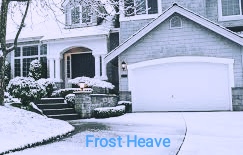Table of Contents
Introduction of Frost Heave
Frost heave is the upward expansion of the ground during freezing conditions caused by the increasing presence of ice as it grows upward from deep within the ground where freezing temperatures have penetrated the ground.

Ice growth requires a water supply that delivers water to the freeze front by capillary action in certain soils. The weight of the overlying soil can retard the vertical growth of ice and promote the formation of lenticular sheets of ice within the soil. However, the force of one or more growing ice lenses is enough to lift the earth’s layers by more than a foot. The soil through which water flows to facilitate ice lens formation must be porous enough to allow capillary action, but not so porous as to disrupt capillary continuity. not. Such soils are called “frost-resistant”. Ice lens growth continuously consumes water rising in the freeze front. Different frost accumulations can crack road surfaces, cause spring potholes, and damage building foundations. Frostbite can occur in mechanically cooled cold stores and skating rinks.
Needle ice is essentially frost heave that occurs early in the freezing season, before the freeze front penetrates very deeply into the ground, and does not need to clear the ground as frost heave.
Working Concept
When freezing temperatures penetrate the soil, the moisture in the soil turns into ice. As moisture freezes in the frozen area, water from other parts of the soil moves towards the frozen area by capillary action. This leads to an increase in ice mass. Weight and other objects on the ground inhibit the growth of ice size, resulting in the formation of ice lenses.
As subzero temperatures penetrate further into the ground, ice lenses are left behind. These ice lenses continue to grow toward cooler regions of the Earth’s surface.
Ice lenses can push the soil layer upwards. It causes cracks in the ground, damaging foundations and subsequently superstructures. Its size is reported to increase by 9% when water turns into ice.
Fine-grained, frost-prone soils, moisture that continuously waters the ice lens, and freezing temperatures are the fundamental components of the frost heave effect. As the temperature cools, the ice melts and the structure sinks back into place under its weight. Repeated freezing and thawing can significantly deteriorate the product and cause it to collapse.
Signs of Frost Heave
Frost heave can occur anywhere exposed to cold temperatures. However, it most commonly occurs when water sources run into poorly drained or frost-prone soils such as clay or silt.
In general, you can tell if it’s this type of soil by touching it. Clay is loose, forms a ball in your hand, and crumbles when you hit it. Silt is made up of tiny particles, and when wet It’s slippery and sticky when you throw it in; it’s also water resistant, so it often puddles when it rains.
Wall cracks are a sign of frost heave. Cracks mostly occur on interior walls, but they can also occur on exterior walls. Other signs of frost heave include cracking, tilting, or slipping of concrete floor slabs.
Effects of Frost Heave
- Destruction of canals in frost season.
- Decreased load-bearing capacity of subsoil.
- Bumps and significant damage to roads.
- Damaged foundations and slabs.
How to Prevent Frost Heave?
- Provision of antifreeze systems such as hot water heating.
- Extend the base like a pillar under the frost line.
- Backfill material such as gravel around the base to improve drainage.
- Use sleeves to keep ice from touching concrete.
- Create a base that will withstand upward movement. For road construction, replace fine frost-prone soil with coarse soil.
- Use a capillary breaker to prevent water migration to the freeze front and consequently reduce the effects of freeze uplift.
- Stabilize the ground.
